九年级英语非谓语动词复习专题 课件(28张PPT,无音频)
文档属性
| 名称 | 九年级英语非谓语动词复习专题 课件(28张PPT,无音频) |  | |
| 格式 | zip | ||
| 文件大小 | 650.5KB | ||
| 资源类型 | 教案 | ||
| 版本资源 | 人教新目标(Go for it)版 | ||
| 科目 | 英语 | ||
| 更新时间 | 2020-05-26 11:04:42 | ||
图片预览

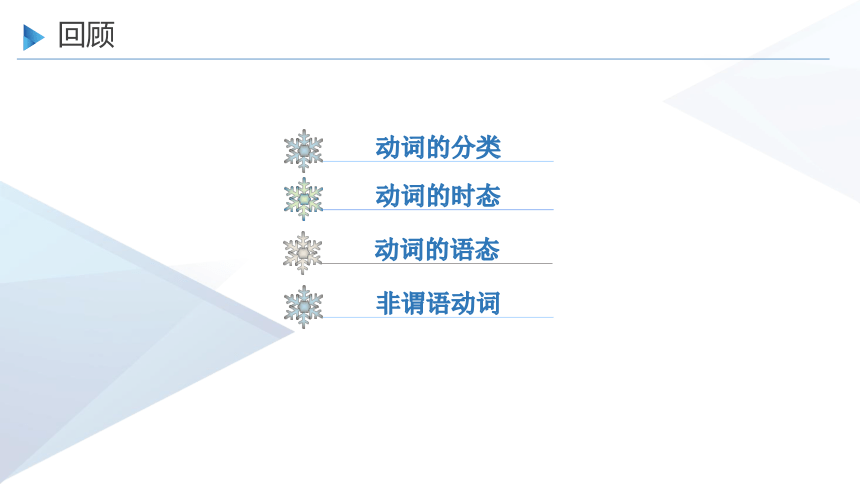

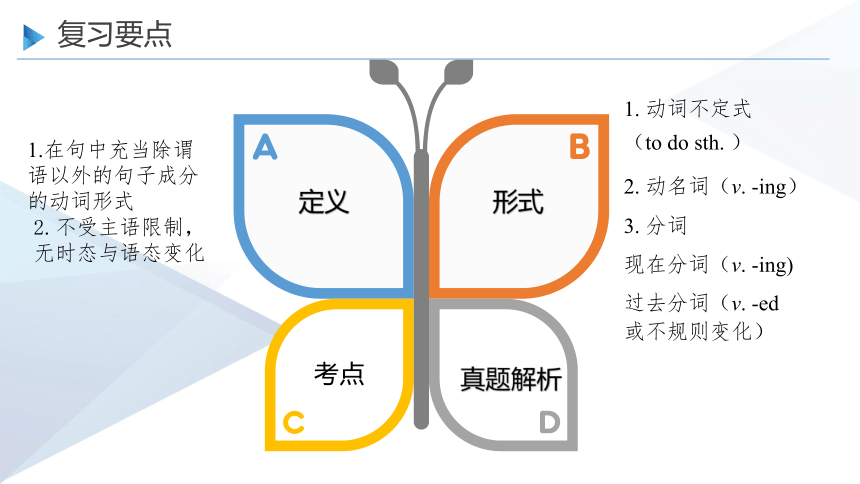

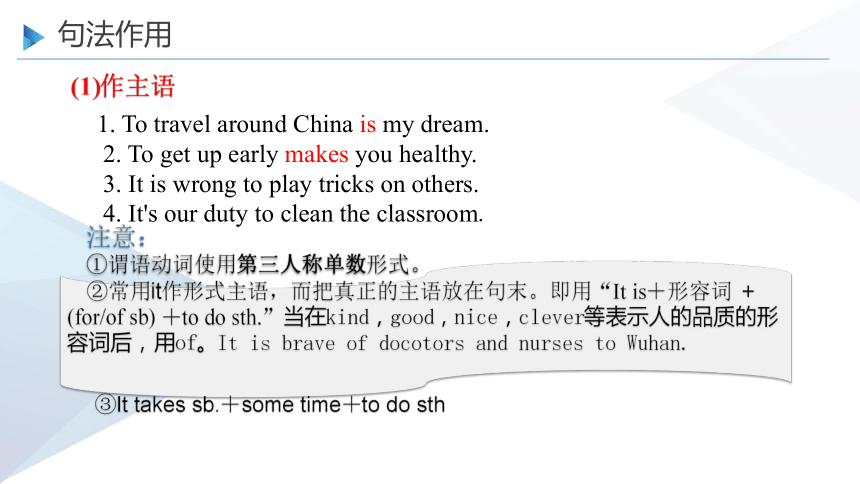
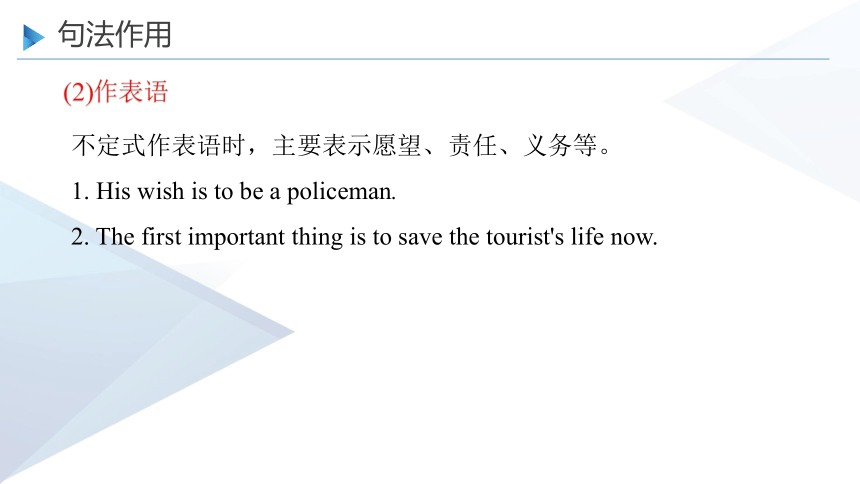
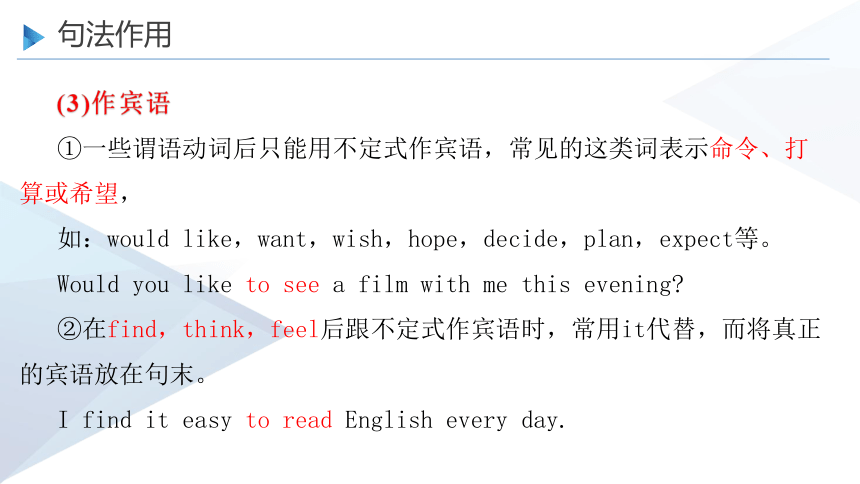
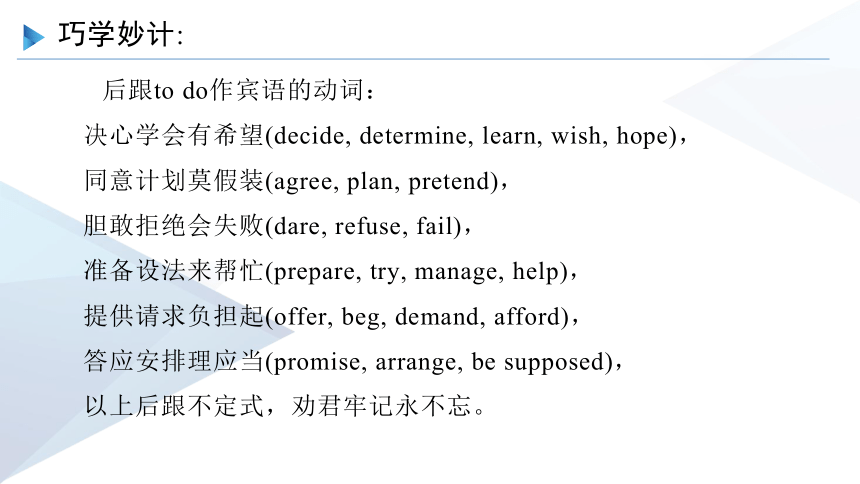
文档简介
(共28张PPT)
非谓语动词
Non-finite
verbs
回顾
动词的分类
动词的时态
动词的语态
非谓语动词
Our
country
is
facing
a
dangerous
enemy
right
now.
It
is
called
novel
coronavirus(新型冠状病毒).
Staying
at
home
is
an
effective
way
of
protection.
We
hope
to
go
back
to
school
soon.
在句子中
不作谓语的动词
叫非谓语动词
谓语or非谓动词
复习要点
定义
形式
考点
真题解析
1.在句中充当除谓语以外的句子成分的动词形式
2.不受主语限制,无时态与语态变化
1.
动词不定式(to
do
sth.
)
2.
动名词(v.
-ing)
3.
分词
现在分词(v.
-ing)
过去分词(v.
-ed或不规则变化)
动词不定式
无人称与数的限制,在句中具有名词、形容词和副词的特征,在句中除了不能作谓语外,可在句中作主语、表语、宾语、宾语补足语、定语和状语等。其基本结构为“to+动词原形”,否定形式为“not+to+动词原形”
My
father
asked
me
not
to
eat
too
much.
考点(一)
句法作用
1.
To
travel
around
China
is
my
dream.
2.
To
get
up
early
makes
you
healthy.
3.
It
is
wrong
to
play
tricks
on
others.
4.
It's
our
duty
to
clean
the
classroom.
注意:
①谓语动词使用第三人称单数形式。
②常用it作形式主语,而把真正的主语放在句末。即用“It
is+形容词
+(for/of
sb)
+to
do
sth.”当在kind,good,nice,clever等表示人的品质的形容词后,用of。It
is
brave
of
docotors
and
nurses
to
Wuhan.
(1)作主语
③It
takes
sb.+some
time+to
do
sth
句法作用
不定式作表语时,主要表示愿望、责任、义务等。
1.
His
wish
is
to
be
a
policeman.
2.
The
first
important
thing
is
to
save
the
tourist's
life
now.
(2)作表语
句法作用
(3)作宾语
①一些谓语动词后只能用不定式作宾语,常见的这类词表示命令、打算或希望,
如:would
like,want,wish,hope,decide,plan,expect等。
Would
you
like
to
see
a
film
with
me
this
evening?
②在find,think,feel后跟不定式作宾语时,常用it代替,而将真正的宾语放在句末。
I
find
it
easy
to
read
English
every
day.
巧学妙计:
后跟to
do作宾语的动词:决心学会有希望(decide,
determine,
learn,
wish,
hope),同意计划莫假装(agree,
plan,
pretend),胆敢拒绝会失败(dare,
refuse,
fail),准备设法来帮忙(prepare,
try,
manage,
help),提供请求负担起(offer,
beg,
demand,
afford),答应安排理应当(promise,
arrange,
be
supposed),以上后跟不定式,劝君牢记永不忘。
省略to的不定式
一感(feel)、二听(hear,listen
to)、三让(let,make,have)、四看(look
at,see,watch,notice)。但在变为被动语态时,不定式符号to要还原。
Kids
like
reading
stories
which
can
make
them
luagh.
句法作用
(4)作定语
I
have
a
lot
of
work
to
do.
The
doctor
said
he
could
do
nothing
to
help
the
boy.
动词不定式短语作定语,须放在所修饰的名词、代词之后。
I
have
a
small
room
to
live
in.
Do
you
have
a
pen
to
write
with?
动词是不及物动词,不能忘掉介词。
句法作用
(5)作状语
1)表原因。
I'm
sorry
to
hear
that.
2)表目的。作目的状语既可放在句首,也可放在句末。
To
keep
healthy,we
should
eat
less
meat.
=We
should
eat
less
meat
to
keep
healthy.
3)表结果。作结果状语时,常与一些有终止意义的动词连用。如:learn,find,see,make等。
A
few
years
later
we
came
to
our
home
to
find
that
our
hometown
had
greatly
changed.
句法作用
(6)作宾语补足语
即“vt.
+sb.
to
do
sth.”句型
I
told
him
not
to
draw
on
the
wall.
My
brother
taught
me
to
read
when
I
was
three.
We
wish
her
to
go
to
a
good
college.
His
mother
warned
him
not
to
go
swimming
in
the
river.
后跟to
do
作宾语补足语的动词或短语列举如下:
告诉、请求、要、命令(tell,
ask,
want,
order)
希望、邀请、教、帮助(wish,
invite,
teach,
help)
警告、喜欢、使(人)恨(warn,
like,
get,
hate)
句法作用
(7)疑问词+动词不定式
动词不定式可以用在疑问词what,
how,
when,
where,
which等之后,作主语、宾语、宾语补足语等。
I
don't
know
what
to
say.
He
showed
me
how
to
use
the
computer.
There
is
no
difference
between
the
two
words.
I
really
don't
know
________.
A.to
choose
which B.which
to
choose
C.to
which
choose
D.to
choose
动名词由动词原形+?ing构成,与现在分词同形。
在句中可作主语、宾语、表语、定语和状语等。
考点二
动名词
句法作用
Eating
too
much
is
bad
for
your
health.
谓语动词用单数
I
like
playing
basketball
very
much.
表示习惯性的动作
My
hobby
is
eating
meat.
多数情况下可转换为动名词作主语
Bill
is
in
the
reading
room.
只表明它所修饰的词的用途、所属关系等
主语
表语
宾语
定语
句法作用
1.其后常接动名词的动词及动词词组有finish,enjoy,practice,understand,mind,keep,consider,miss,avoid(避免),suggest,admit,be
worth,have
difficulty/problems/trouble/fun,waste
time,can't
help/can't
stop,be
used
to(习惯于),所有介词等
2.
其后既可以接动名词,也可接动词不定式的动词有love,like,prefer,begin,start,continue,remember,try,stop,forget,hate,need,allow,go
on等。
牢记
一旦开始莫后悔(begin,start,regret)
爱憎分明要切记(like,love,hate,remember,forget)
继续努力有打算(continue,try,mean)三个需要更喜欢(need,want,require,prefer)
动词后接不定式与动名词的区别
1.forget
doing
sth忘记做过某事(已做)
forget
to
do
sth
忘记去做某事(未做)
2.remember
doing
sth
(已做)
/
remember
to
do
sth(未做)
3.go
on
to
do(继续去做别的事)/
go
on
doing(继续做某事)
(2019滨州)Yet
he
went
on____
(work)
hard
to
become
an
excellent
scientist
4.
try
to
do(努力)/
try
doing
(尝试)
5.stop
to
do
(将要)/stop
doing
(现在)
working
考点三
现在分词
分词
过去分词
由“动词+?ing”构成
主动、进行之意
动词+?ed
有被动、完成之意
分词的句法功能
功 能
说 明
例 句
定 语
现在分词作定语,其逻辑主语是它所修饰的词;过去分词作定语,其逻辑宾语是它所修饰的词。
1.
Do
you
know
the
girl
singing
in
the
room?
2.
Do
you
know
a
girl
called
Linda?
状 语
作状语时,表示时间、原因、条件、结果、伴随状态等。现在分词作状语时,其逻辑主语是句子的主语;过去分词作状语时,其与句子的主语存在逻辑上的动宾关系。
1.
The
students
went
out
of
the
classroom,talking
and
laughing.
2.Working
there,he
was
an
advanced
worker.
3.Bitten
by
the
neighbor's
dog,he
dare
not
go
there
any
more.
4.Left?to?itself?in?the?room,?the?baby?began?to?cry.
分词的句法功能
功 能
说 明
例 句
表 语
现在分词多指主语的性质、特征,过去分词说明主语的状态。
The
opera
is
very
moving.
The
boy
is
too
excited
to
say
a
word.
补足语
现在分词作补足语,被补足的宾语或主语是它的逻辑主语(即主动关系);过去分词作补足语,被补足的宾语或主语是它的逻辑宾语(即被动关系)。
1.Don't
keep
us
waiting
for
a
long
time.
2.
I
heard
him
singing
in
the
classroom.
3.
He'll
have
his
hair
cut
after
school.
区别:①在语态上,现在分词表示主动意义,过去分词表示被动意义。
a
surprising
news
a
surprised
man
一个受惊吓的人
②在时间上,现在分词表示正在进行的动作,过去分词表示已经完成的动作。
the
developing
country
发展中国家
the
developed
country
发达国家
真题演练
1.
—Do
you
know
whether
the
man
_______
by
the
door
is
Mr.
Smith?
—Sure.
We’ve
known
each
other
for
a
long
time.
A.
stand
B.
standing
C.
stood
D.
stands
现在分词短语作后置定语表示动作正在进行
2.
It’s
dangerous
_______
with
the
wild
animal.
A.
for
us
to
play
B.
of
us
playing
C.
for
us
playing
D.
of
us
to
play
真题演练
3.【2019
?
广西省贵港市】—I
have
trouble
the
new
word.
Can
you
help
me?
—Sure.
You
can
look
it
up
in
the
dictionary.
A.
understanding
B.
to
understand
C.
understand
D.
understood
4.【2019
?
江苏省镇江市】To
my
surprise,
Daniel’s
parents
allowed
him
_________
Shanghai
Disneyland
with
me.
A.
to
visit
B.
visiting
C.
visit
D.
visits
真题演练
5.
(山东泰安)When
you
leave,please
turn
off
the
lights___energy.
A.
save
B.
saving
C.
to
save
D.
saved
6.
(2019·定西)Hongkong
Disneyland
is
well
worth________.
A.
to
visit
B.
visited
C.
visit
D.
visiting
7.
He
often
drinks
two
cups
of
________
water
when
he
comes
back.
A.
boiling
B.
boil
C.
boiled
D.
boils
真题演练
8.—I
feel
a
bit
hungry
now.
—Why
not
________for
dinner
with
us?
A.go
B.did
you
go
C.to
go
D.do
you
go
9.
(2019·南京)
—Do
you
have
any
plans
for
the
holiday?
—Yes,
I'm
planning
to
travel
to
Jiuzhaigou.
I'm
looking
forward
to
____the
colourful
lakes
and
amazing
waterfalls.
A.
see
B.
seeing
C.
sees
D.saw
10.
(新疆)I
used
to
____newspapers
and
watch
TV
after
dinner.But
now
I
'm
used
to
____
a
walk.
A
read
take
B
read
taking
C
reading
taking
D
reading
take
动词应用(2019
滨州)
Have
you
ever
read
the
book
A
brief
History
of
Times?
It
(71)
___________(write)
by
Stephen
Hawking
in
2013.
Stephen
Hawking
was
born
on
January
8th,
1942,
exactly
300
years
after
the
death
of
Galileo
in
Oxford,
England.
At
the
age
of
eleven,
Stephen
went
to
Oxford
University,
his
father’s
old
college.
After
three
years,
he
won
a
first
class
honour
degree
in
(72)
______________(nature)
science.
In
October
1962,
Stephen
arrived
at
the
University
of
Cambridge
(73)
___________(do)
research.
He
(74)
_________(real)
enjoyed
his
time
there.
Unluckily,
Stephen
had
a
bad
(75)
_____________(ill)
shortly
after
his
21st
birthday
in
1963
and
was
given
two
years
to
live.
Yet
he
went
on
(76)
___________(work)
hard
to
become
an
excellent
scientist.
Stephen
didn’t
live
by
(77)
___________(he),
he
fell
in
love
with
Jane
Wilde
and
they
got
(78)
___________(marry)
in
1665,
then
they
had
three
(79)
____________(child).
Hawking
liked
China
very
much,
he
had
visited
China
several
times.
On
November
24th,
2017,Hawking
(80)
___________(reply)
Wang
Junkai
on
his
Weibo.
He
said
he
was
pleased
to
answer
the
excellent
question
from
Mr.
Wang
Junkai.
was
written
natural
to
do
really
illness
working
married
himself
children
replied
一看标志;
二定时态;
三写构成。
非谓语动词
动词不定式
做主语
作宾语
作宾补
作表语
分词
作定语
作状语
作表语
作补足语
动名词
作主语
作宾语
作表语
作定语
作状语
作定语
Summary
Thank
You
!
非谓语动词
Non-finite
verbs
回顾
动词的分类
动词的时态
动词的语态
非谓语动词
Our
country
is
facing
a
dangerous
enemy
right
now.
It
is
called
novel
coronavirus(新型冠状病毒).
Staying
at
home
is
an
effective
way
of
protection.
We
hope
to
go
back
to
school
soon.
在句子中
不作谓语的动词
叫非谓语动词
谓语or非谓动词
复习要点
定义
形式
考点
真题解析
1.在句中充当除谓语以外的句子成分的动词形式
2.不受主语限制,无时态与语态变化
1.
动词不定式(to
do
sth.
)
2.
动名词(v.
-ing)
3.
分词
现在分词(v.
-ing)
过去分词(v.
-ed或不规则变化)
动词不定式
无人称与数的限制,在句中具有名词、形容词和副词的特征,在句中除了不能作谓语外,可在句中作主语、表语、宾语、宾语补足语、定语和状语等。其基本结构为“to+动词原形”,否定形式为“not+to+动词原形”
My
father
asked
me
not
to
eat
too
much.
考点(一)
句法作用
1.
To
travel
around
China
is
my
dream.
2.
To
get
up
early
makes
you
healthy.
3.
It
is
wrong
to
play
tricks
on
others.
4.
It's
our
duty
to
clean
the
classroom.
注意:
①谓语动词使用第三人称单数形式。
②常用it作形式主语,而把真正的主语放在句末。即用“It
is+形容词
+(for/of
sb)
+to
do
sth.”当在kind,good,nice,clever等表示人的品质的形容词后,用of。It
is
brave
of
docotors
and
nurses
to
Wuhan.
(1)作主语
③It
takes
sb.+some
time+to
do
sth
句法作用
不定式作表语时,主要表示愿望、责任、义务等。
1.
His
wish
is
to
be
a
policeman.
2.
The
first
important
thing
is
to
save
the
tourist's
life
now.
(2)作表语
句法作用
(3)作宾语
①一些谓语动词后只能用不定式作宾语,常见的这类词表示命令、打算或希望,
如:would
like,want,wish,hope,decide,plan,expect等。
Would
you
like
to
see
a
film
with
me
this
evening?
②在find,think,feel后跟不定式作宾语时,常用it代替,而将真正的宾语放在句末。
I
find
it
easy
to
read
English
every
day.
巧学妙计:
后跟to
do作宾语的动词:决心学会有希望(decide,
determine,
learn,
wish,
hope),同意计划莫假装(agree,
plan,
pretend),胆敢拒绝会失败(dare,
refuse,
fail),准备设法来帮忙(prepare,
try,
manage,
help),提供请求负担起(offer,
beg,
demand,
afford),答应安排理应当(promise,
arrange,
be
supposed),以上后跟不定式,劝君牢记永不忘。
省略to的不定式
一感(feel)、二听(hear,listen
to)、三让(let,make,have)、四看(look
at,see,watch,notice)。但在变为被动语态时,不定式符号to要还原。
Kids
like
reading
stories
which
can
make
them
luagh.
句法作用
(4)作定语
I
have
a
lot
of
work
to
do.
The
doctor
said
he
could
do
nothing
to
help
the
boy.
动词不定式短语作定语,须放在所修饰的名词、代词之后。
I
have
a
small
room
to
live
in.
Do
you
have
a
pen
to
write
with?
动词是不及物动词,不能忘掉介词。
句法作用
(5)作状语
1)表原因。
I'm
sorry
to
hear
that.
2)表目的。作目的状语既可放在句首,也可放在句末。
To
keep
healthy,we
should
eat
less
meat.
=We
should
eat
less
meat
to
keep
healthy.
3)表结果。作结果状语时,常与一些有终止意义的动词连用。如:learn,find,see,make等。
A
few
years
later
we
came
to
our
home
to
find
that
our
hometown
had
greatly
changed.
句法作用
(6)作宾语补足语
即“vt.
+sb.
to
do
sth.”句型
I
told
him
not
to
draw
on
the
wall.
My
brother
taught
me
to
read
when
I
was
three.
We
wish
her
to
go
to
a
good
college.
His
mother
warned
him
not
to
go
swimming
in
the
river.
后跟to
do
作宾语补足语的动词或短语列举如下:
告诉、请求、要、命令(tell,
ask,
want,
order)
希望、邀请、教、帮助(wish,
invite,
teach,
help)
警告、喜欢、使(人)恨(warn,
like,
get,
hate)
句法作用
(7)疑问词+动词不定式
动词不定式可以用在疑问词what,
how,
when,
where,
which等之后,作主语、宾语、宾语补足语等。
I
don't
know
what
to
say.
He
showed
me
how
to
use
the
computer.
There
is
no
difference
between
the
two
words.
I
really
don't
know
________.
A.to
choose
which B.which
to
choose
C.to
which
choose
D.to
choose
动名词由动词原形+?ing构成,与现在分词同形。
在句中可作主语、宾语、表语、定语和状语等。
考点二
动名词
句法作用
Eating
too
much
is
bad
for
your
health.
谓语动词用单数
I
like
playing
basketball
very
much.
表示习惯性的动作
My
hobby
is
eating
meat.
多数情况下可转换为动名词作主语
Bill
is
in
the
reading
room.
只表明它所修饰的词的用途、所属关系等
主语
表语
宾语
定语
句法作用
1.其后常接动名词的动词及动词词组有finish,enjoy,practice,understand,mind,keep,consider,miss,avoid(避免),suggest,admit,be
worth,have
difficulty/problems/trouble/fun,waste
time,can't
help/can't
stop,be
used
to(习惯于),所有介词等
2.
其后既可以接动名词,也可接动词不定式的动词有love,like,prefer,begin,start,continue,remember,try,stop,forget,hate,need,allow,go
on等。
牢记
一旦开始莫后悔(begin,start,regret)
爱憎分明要切记(like,love,hate,remember,forget)
继续努力有打算(continue,try,mean)三个需要更喜欢(need,want,require,prefer)
动词后接不定式与动名词的区别
1.forget
doing
sth忘记做过某事(已做)
forget
to
do
sth
忘记去做某事(未做)
2.remember
doing
sth
(已做)
/
remember
to
do
sth(未做)
3.go
on
to
do(继续去做别的事)/
go
on
doing(继续做某事)
(2019滨州)Yet
he
went
on____
(work)
hard
to
become
an
excellent
scientist
4.
try
to
do(努力)/
try
doing
(尝试)
5.stop
to
do
(将要)/stop
doing
(现在)
working
考点三
现在分词
分词
过去分词
由“动词+?ing”构成
主动、进行之意
动词+?ed
有被动、完成之意
分词的句法功能
功 能
说 明
例 句
定 语
现在分词作定语,其逻辑主语是它所修饰的词;过去分词作定语,其逻辑宾语是它所修饰的词。
1.
Do
you
know
the
girl
singing
in
the
room?
2.
Do
you
know
a
girl
called
Linda?
状 语
作状语时,表示时间、原因、条件、结果、伴随状态等。现在分词作状语时,其逻辑主语是句子的主语;过去分词作状语时,其与句子的主语存在逻辑上的动宾关系。
1.
The
students
went
out
of
the
classroom,talking
and
laughing.
2.Working
there,he
was
an
advanced
worker.
3.Bitten
by
the
neighbor's
dog,he
dare
not
go
there
any
more.
4.Left?to?itself?in?the?room,?the?baby?began?to?cry.
分词的句法功能
功 能
说 明
例 句
表 语
现在分词多指主语的性质、特征,过去分词说明主语的状态。
The
opera
is
very
moving.
The
boy
is
too
excited
to
say
a
word.
补足语
现在分词作补足语,被补足的宾语或主语是它的逻辑主语(即主动关系);过去分词作补足语,被补足的宾语或主语是它的逻辑宾语(即被动关系)。
1.Don't
keep
us
waiting
for
a
long
time.
2.
I
heard
him
singing
in
the
classroom.
3.
He'll
have
his
hair
cut
after
school.
区别:①在语态上,现在分词表示主动意义,过去分词表示被动意义。
a
surprising
news
a
surprised
man
一个受惊吓的人
②在时间上,现在分词表示正在进行的动作,过去分词表示已经完成的动作。
the
developing
country
发展中国家
the
developed
country
发达国家
真题演练
1.
—Do
you
know
whether
the
man
_______
by
the
door
is
Mr.
Smith?
—Sure.
We’ve
known
each
other
for
a
long
time.
A.
stand
B.
standing
C.
stood
D.
stands
现在分词短语作后置定语表示动作正在进行
2.
It’s
dangerous
_______
with
the
wild
animal.
A.
for
us
to
play
B.
of
us
playing
C.
for
us
playing
D.
of
us
to
play
真题演练
3.【2019
?
广西省贵港市】—I
have
trouble
the
new
word.
Can
you
help
me?
—Sure.
You
can
look
it
up
in
the
dictionary.
A.
understanding
B.
to
understand
C.
understand
D.
understood
4.【2019
?
江苏省镇江市】To
my
surprise,
Daniel’s
parents
allowed
him
_________
Shanghai
Disneyland
with
me.
A.
to
visit
B.
visiting
C.
visit
D.
visits
真题演练
5.
(山东泰安)When
you
leave,please
turn
off
the
lights___energy.
A.
save
B.
saving
C.
to
save
D.
saved
6.
(2019·定西)Hongkong
Disneyland
is
well
worth________.
A.
to
visit
B.
visited
C.
visit
D.
visiting
7.
He
often
drinks
two
cups
of
________
water
when
he
comes
back.
A.
boiling
B.
boil
C.
boiled
D.
boils
真题演练
8.—I
feel
a
bit
hungry
now.
—Why
not
________for
dinner
with
us?
A.go
B.did
you
go
C.to
go
D.do
you
go
9.
(2019·南京)
—Do
you
have
any
plans
for
the
holiday?
—Yes,
I'm
planning
to
travel
to
Jiuzhaigou.
I'm
looking
forward
to
____the
colourful
lakes
and
amazing
waterfalls.
A.
see
B.
seeing
C.
sees
D.saw
10.
(新疆)I
used
to
____newspapers
and
watch
TV
after
dinner.But
now
I
'm
used
to
____
a
walk.
A
read
take
B
read
taking
C
reading
taking
D
reading
take
动词应用(2019
滨州)
Have
you
ever
read
the
book
A
brief
History
of
Times?
It
(71)
___________(write)
by
Stephen
Hawking
in
2013.
Stephen
Hawking
was
born
on
January
8th,
1942,
exactly
300
years
after
the
death
of
Galileo
in
Oxford,
England.
At
the
age
of
eleven,
Stephen
went
to
Oxford
University,
his
father’s
old
college.
After
three
years,
he
won
a
first
class
honour
degree
in
(72)
______________(nature)
science.
In
October
1962,
Stephen
arrived
at
the
University
of
Cambridge
(73)
___________(do)
research.
He
(74)
_________(real)
enjoyed
his
time
there.
Unluckily,
Stephen
had
a
bad
(75)
_____________(ill)
shortly
after
his
21st
birthday
in
1963
and
was
given
two
years
to
live.
Yet
he
went
on
(76)
___________(work)
hard
to
become
an
excellent
scientist.
Stephen
didn’t
live
by
(77)
___________(he),
he
fell
in
love
with
Jane
Wilde
and
they
got
(78)
___________(marry)
in
1665,
then
they
had
three
(79)
____________(child).
Hawking
liked
China
very
much,
he
had
visited
China
several
times.
On
November
24th,
2017,Hawking
(80)
___________(reply)
Wang
Junkai
on
his
Weibo.
He
said
he
was
pleased
to
answer
the
excellent
question
from
Mr.
Wang
Junkai.
was
written
natural
to
do
really
illness
working
married
himself
children
replied
一看标志;
二定时态;
三写构成。
非谓语动词
动词不定式
做主语
作宾语
作宾补
作表语
分词
作定语
作状语
作表语
作补足语
动名词
作主语
作宾语
作表语
作定语
作状语
作定语
Summary
Thank
You
!
同课章节目录
- 词法
- 名词
- 动词和动词短语
- 动词语态
- 动词时态
- 助动词和情态动词
- 非谓语动词
- 冠词
- 代词
- 数词和量词
- 形容词副词及其比较等级
- 介词和介词短语
- 连词和感叹词
- 构词法
- 相似、相近词比较
- 句法
- 陈述句
- 一般疑问句和否定疑问句
- 特殊疑问句及选择疑问句
- 反意疑问句
- 存在句(There be句型)
- 宾语从句
- 定语从句
- 状语从句
- 主谓一致问题
- 简单句
- 并列句
- 复合句
- 主谓一致
- 主、表语从句
- 名词性从句
- 直接引语和间接引语
- 虚拟语气
- 感叹句
- 强调句
- 倒装句
- 祈使句
- 句子的成分
- 句子的分类
- 题型专区
- 单项选择部分
- 易错题
- 完形填空
- 阅读理解
- 词汇练习
- 听说训练
- 句型转换
- 补全对话
- 短文改错
- 翻译
- 书面表达
- 任务型阅读
- 语法填空
- 其他资料
